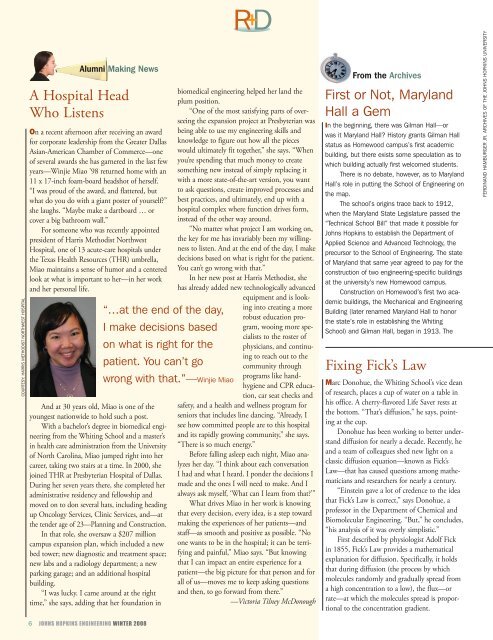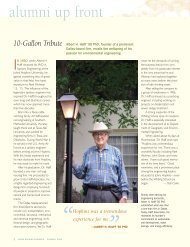Whither the Job Market?: - Johns Hopkins University Whiting School ...
Whither the Job Market?: - Johns Hopkins University Whiting School ...
Whither the Job Market?: - Johns Hopkins University Whiting School ...
Create successful ePaper yourself
Turn your PDF publications into a flip-book with our unique Google optimized e-Paper software.
couRTESy: HARRiS METHoDiST NoRTHWEST HoSPiTAL<br />
alumni making news<br />
A Hospital Head<br />
Who Listens<br />
On a recent afternoon after receiving an award<br />
for corporate leadership from <strong>the</strong> Greater Dallas<br />
Asian-American Chamber of Commerce—one<br />
of several awards she has garnered in <strong>the</strong> last few<br />
years—Winjie Miao ’98 returned home with an<br />
11 x 17-inch foam-board headshot of herself.<br />
“I was proud of <strong>the</strong> award, and flattered, but<br />
what do you do with a giant poster of yourself?”<br />
she laughs. “Maybe make a dartboard … or<br />
cover a big bathroom wall.”<br />
For someone who was recently appointed<br />
president of Harris Methodist Northwest<br />
Hospital, one of 13 acute-care hospitals under<br />
<strong>the</strong> Texas Health resources (THr) umbrella,<br />
Miao maintains a sense of humor and a centered<br />
look at what is important to her—in her work<br />
and her personal life.<br />
And at 30 years old, Miao is one of <strong>the</strong><br />
youngest nationwide to hold such a post.<br />
With a bachelor’s degree in biomedical engineering<br />
from <strong>the</strong> <strong>Whiting</strong> <strong>School</strong> and a master’s<br />
in health care administration from <strong>the</strong> <strong>University</strong><br />
of North Carolina, Miao jumped right into her<br />
career, taking two stairs at a time. In 2000, she<br />
joined THr at Presbyterian Hospital of Dallas.<br />
During her seven years <strong>the</strong>re, she completed her<br />
administrative residency and fellowship and<br />
moved on to don several hats, including heading<br />
up Oncology Services, Clinic Services, and—at<br />
<strong>the</strong> tender age of 23—Planning and Construction.<br />
In that role, she oversaw a $207 million<br />
campus expansion plan, which included a new<br />
bed tower; new diagnostic and treatment space;<br />
new labs and a radiology department; a new<br />
parking garage; and an additional hospital<br />
building.<br />
“I was lucky. I came around at <strong>the</strong> right<br />
time,” she says, adding that her foundation in<br />
6 JOHNs HOpkiNs ENGiNEERiNG WiNTER 2008<br />
“…at <strong>the</strong> end of <strong>the</strong> day,<br />
i make decisions based<br />
on what is right for <strong>the</strong><br />
patient. you can’t go<br />
wrong with that.”—Winjie Miao<br />
biomedical engineering helped her land <strong>the</strong><br />
plum position.<br />
“One of <strong>the</strong> most satisfying parts of overseeing<br />
<strong>the</strong> expansion project at Presbyterian was<br />
being able to use my engineering skills and<br />
knowledge to figure out how all <strong>the</strong> pieces<br />
would ultimately fit toge<strong>the</strong>r,” she says. “When<br />
you’re spending that much money to create<br />
something new instead of simply replacing it<br />
with a more state-of-<strong>the</strong>-art version, you want<br />
to ask questions, create improved processes and<br />
best practices, and ultimately, end up with a<br />
hospital complex where function drives form,<br />
instead of <strong>the</strong> o<strong>the</strong>r way around.<br />
“No matter what project I am working on,<br />
<strong>the</strong> key for me has invariably been my willingness<br />
to listen. And at <strong>the</strong> end of <strong>the</strong> day, I make<br />
decisions based on what is right for <strong>the</strong> patient.<br />
You can’t go wrong with that.”<br />
In her new post at Harris Methodist, she<br />
has already added new technologically advanced<br />
equipment and is looking<br />
into creating a more<br />
robust education program,<br />
wooing more specialists<br />
to <strong>the</strong> roster of<br />
physicians, and continuing<br />
to reach out to <strong>the</strong><br />
community through<br />
programs like handhygiene<br />
and CPr education,<br />
car seat checks and<br />
safety, and a health and wellness program for<br />
seniors that includes line dancing. “Already, I<br />
see how committed people are to this hospital<br />
and its rapidly growing community,” she says.<br />
“There is so much energy.”<br />
Before falling asleep each night, Miao analyzes<br />
her day. “I think about each conversation<br />
I had and what I heard. I ponder <strong>the</strong> decisions I<br />
made and <strong>the</strong> ones I will need to make. And I<br />
always ask myself, ‘What can I learn from that?’”<br />
What drives Miao in her work is knowing<br />
that every decision, every idea, is a step toward<br />
making <strong>the</strong> experiences of her patients—and<br />
staff—as smooth and positive as possible. “No<br />
one wants to be in <strong>the</strong> hospital; it can be terrifying<br />
and painful,” Miao says. “But knowing<br />
that I can impact an entire experience for a<br />
patient—<strong>the</strong> big picture for that person and for<br />
all of us—moves me to keep asking questions<br />
and <strong>the</strong>n, to go forward from <strong>the</strong>re.”<br />
—Victoria Tilney McDonough<br />
from <strong>the</strong> archives<br />
First or Not, Maryland<br />
Hall a gem<br />
In <strong>the</strong> beginning, <strong>the</strong>re was gilman Hall—or<br />
was it Maryland Hall? History grants gilman Hall<br />
status as Homewood campus’s first academic<br />
building, but <strong>the</strong>re exists some speculation as to<br />
which building actually first welcomed students.<br />
There is no debate, however, as to Maryland<br />
Hall’s role in putting <strong>the</strong> <strong>School</strong> of Engineering on<br />
<strong>the</strong> map.<br />
The school’s origins trace back to 1912,<br />
when <strong>the</strong> Maryland State Legislature passed <strong>the</strong><br />
“Technical <strong>School</strong> Bill” that made it possible for<br />
<strong>Johns</strong> <strong>Hopkins</strong> to establish <strong>the</strong> Department of<br />
Applied Science and Advanced Technology, <strong>the</strong><br />
precursor to <strong>the</strong> <strong>School</strong> of Engineering. The state<br />
of Maryland that same year agreed to pay for <strong>the</strong><br />
construction of two engineering-specific buildings<br />
at <strong>the</strong> university’s new Homewood campus.<br />
construction on Homewood’s first two academic<br />
buildings, <strong>the</strong> Mechanical and Engineering<br />
Building (later renamed Maryland Hall to honor<br />
<strong>the</strong> state’s role in establishing <strong>the</strong> <strong>Whiting</strong><br />
<strong>School</strong>) and gilman Hall, began in 1913. The<br />
Fixing Fick’s Law<br />
Marc Donohue, <strong>the</strong> <strong>Whiting</strong> <strong>School</strong>’s vice dean<br />
of research, places a cup of water on a table in<br />
his office. A cherry-flavored Life Saver rests at<br />
<strong>the</strong> bottom. “That’s diffusion,” he says, pointing<br />
at <strong>the</strong> cup.<br />
Donohue has been working to better understand<br />
diffusion for nearly a decade. recently, he<br />
and a team of colleagues shed new light on a<br />
classic diffusion equation—known as Fick’s<br />
Law—that has caused questions among ma<strong>the</strong>maticians<br />
and researchers for nearly a century.<br />
“Einstein gave a lot of credence to <strong>the</strong> idea<br />
that Fick’s Law is correct,” says Donohue, a<br />
professor in <strong>the</strong> Department of Chemical and<br />
Biomolecular Engineering. “But,” he concludes,<br />
“his analysis of it was overly simplistic.”<br />
First described by physiologist Adolf Fick<br />
in 1855, Fick’s Law provides a ma<strong>the</strong>matical<br />
explanation for diffusion. Specifically, it holds<br />
that during diffusion (<strong>the</strong> process by which<br />
molecules randomly and gradually spread from<br />
a high concentration to a low), <strong>the</strong> flux—or<br />
rate—at which <strong>the</strong> molecules spread is proportional<br />
to <strong>the</strong> concentration gradient.<br />
FERDiNAND HAMBuRgER JR. ARcHivES oF THE JoHNS HoPKiNS uNivERSiTy





